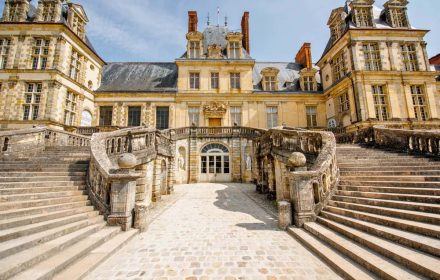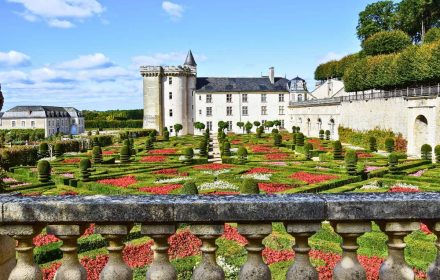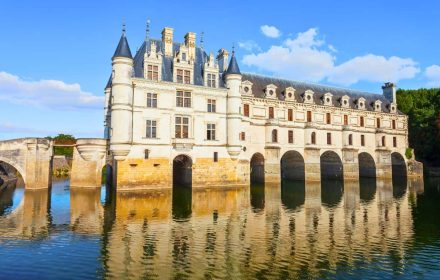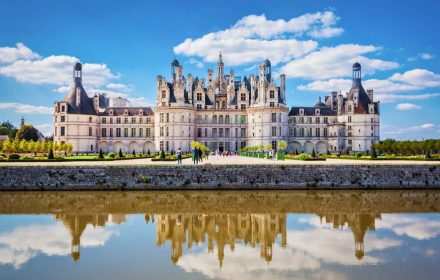This site uses affiliate links, meaning that if you make a purchase through our links, we may earn an affiliate commission.
If you’re planning a trip through the Loire Valley, you’ve probably seen photos of Château d’Azay-le-Rideau with its graceful towers reflected in the water like something out of a fairytale. But pictures don’t quite do it justice.
If you’re wondering what to see at Château d’Azay-le-Rideau, I’ve got you covered. This post shares my favorite parts of the visit, a few hidden corners you might miss, and some simple tips to help make your time here smooth and memorable.
It’s a smaller château, but it leaves a lasting impression!
- 1. Brief History of Château d'Azay-le-Rideau
- 2. What to See at Château d'Azay-le-Rideau
-
- 2.1. The Main Courtyard (Cour d’Honneur)
- 2.2. The Grand Staircase (Escalier d’Honneur)
- 2.3. The Attic (Grand Comble)
- 2.4. Renaissance Chamber (Chambre Renaissance)
- 2.5. Psyche’s Chamber (Chambre de Psyché)
- 2.6. The Great Hall (Grande salle)
- 2.7. King’s Chamber (Chambre du Roi)
- 2.8. Biencourt Salon (Salon Biencourt)
- 2.9. Billiards Room (Salle de billard)
- 2.10. Dining Room (Salle à manger)
- 2.11. Salon-Library (Salon-Bibliothèque)
- 2.12. The Gardens
- 3. Practical Tips for Visiting Château d'Azay-le-Rideau
Brief History of Château d'Azay-le-Rideau
Château d’Azay-le-Rideau may look like a castle from a storybook, but its history is firmly rooted in France’s Renaissance past. Construction began around 1518 under Gilles Berthelot, a wealthy man who served as Treasurer to King Francis I.
Inspired by the new Italian style that was sweeping through France at the time, Berthelot set out to build a residence that was elegant, modern, and completely different from the fortified medieval castles of the past.
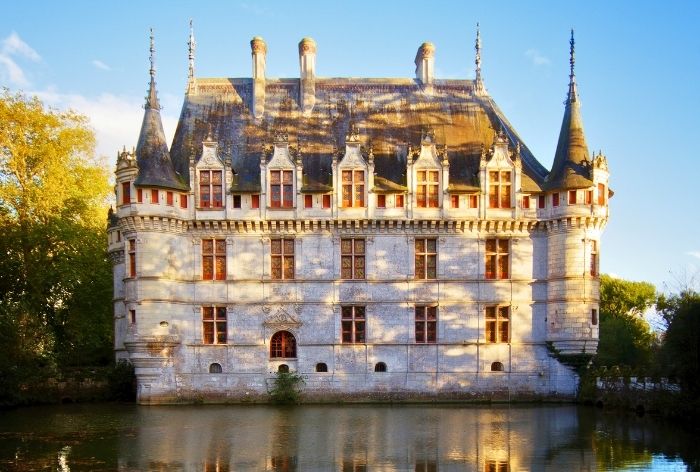
Château d’Azay-le-Rideau
The château was built right on an island in the Indre River, giving it the beautiful mirrored look it still has today.
But Berthelot’s dream didn’t last long. He was accused of financial misconduct, basically, misusing royal funds, and had to flee the country in 1527. The crown seized the château, and construction was left unfinished for a time.
Over the centuries, the château passed through several noble families. In the 18th and 19th centuries, the Marquis de Biencourt and his descendants took over and carried out major restoration work. They added to the interiors, created the English-style landscaped park that surrounds the château, and turned it into a place of elegance and culture. The Biencourt family also assembled an important collection of historical portraits, some of which you can still see inside.
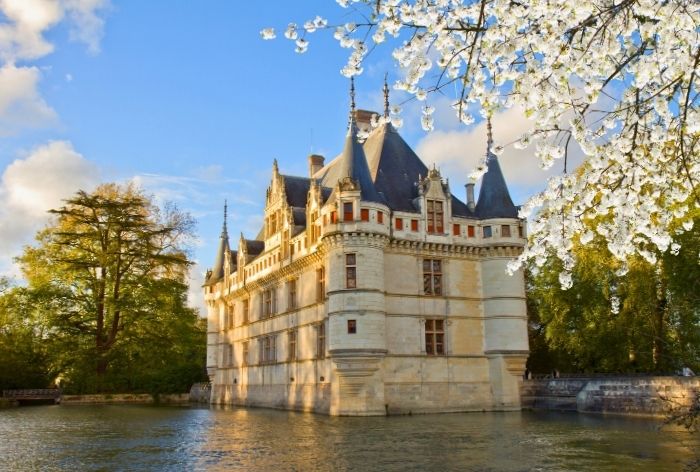
Château d’Azay-le-Rideau
In 1905, the French state purchased the château, and it was declared a historic monument. Since then, it has been carefully preserved and restored. Today, it’s considered one of the finest examples of early French Renaissance architecture, with its mix of Gothic structure and Italian-inspired decoration, and it’s part of the prestigious Loire Valley UNESCO World Heritage site.
What to See at Château d'Azay-le-Rideau
The Main Courtyard (Cour d’Honneur)
The moment you step into the Main Courtyard of Château d’Azay-le-Rideau, you get a real sense of the elegance and ambition behind this place. Known as the Cour d’Honneur, this space was designed to impress.
Surrounded on two sides by finely detailed stone façades, the courtyard creates a perfect frame for the château’s Renaissance beauty.
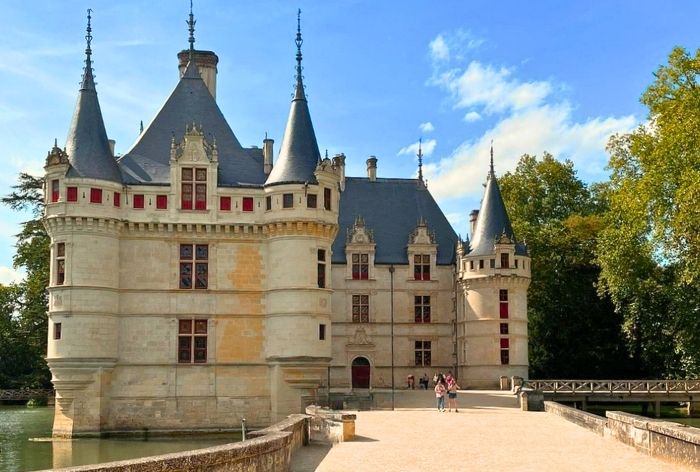
Château d’Azay-le-Rideau
The building is made from pale local limestone called tuffeau, which catches the light beautifully, especially in the early morning or late afternoon. Look closely, and you’ll notice intricate carvings and evenly spaced windows that give everything a sense of balance and grace.
Although the château was never meant to be a fortress, there are still hints of its medieval roots. Along the roofline, you’ll spot machicolations, those stone overhangs once used for defense, and a covered walkway that would have been part of the original design.
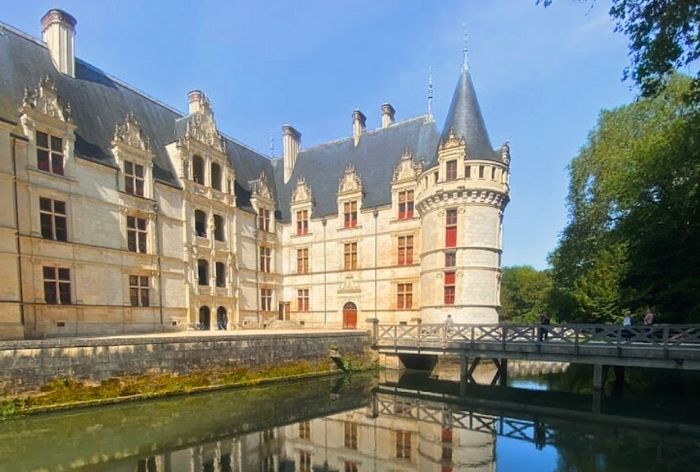
Château d’Azay-le-Rideau
The courtyard also sets the stage for one of the château’s most iconic features: the Grand Staircase. From here, you can see its richly decorated façade, which you explore in the next section.
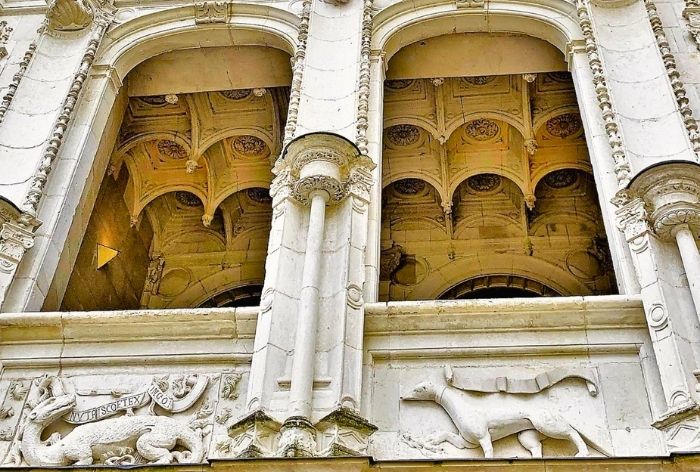
The Grand Staircase / What to See at Chateau d’Azay-le-Rideau
The Grand Staircase (Escalier d’Honneur)
One of the standout features of Château d’Azay-le-Rideau is its Grand Staircase, Escalier d’Honneur, which was a bold and modern design for its time. It was one of the very first straight-flight staircases in a French château. Before this, most staircases were narrow spirals hidden inside towers.
From the courtyard, you can see its beautifully sculpted exterior. The walls are decorated with delicate stone carvings, columns, medallions, and arches that clearly show the influence of Italian Renaissance style.
If you look closely, you’ll spot symbols carved into the stone: the salamander of King Francis I (a nod to royal support) and the initials of the château’s original owners, Gilles Berthelot and Philippe Lesbahy.
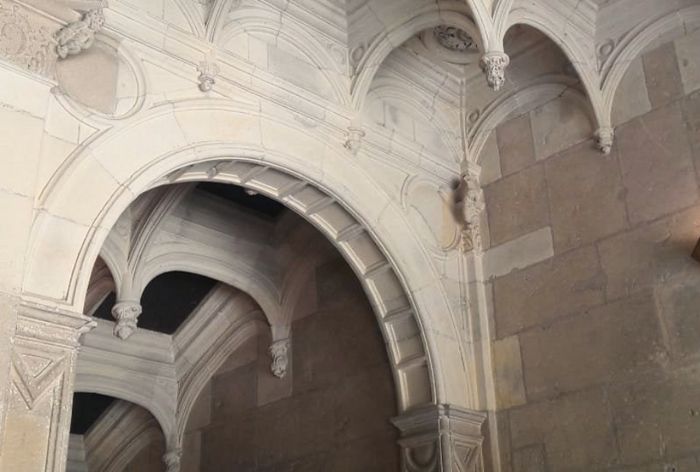
The Grand Staircase / What to See at Château d’Azay-le-Rideau
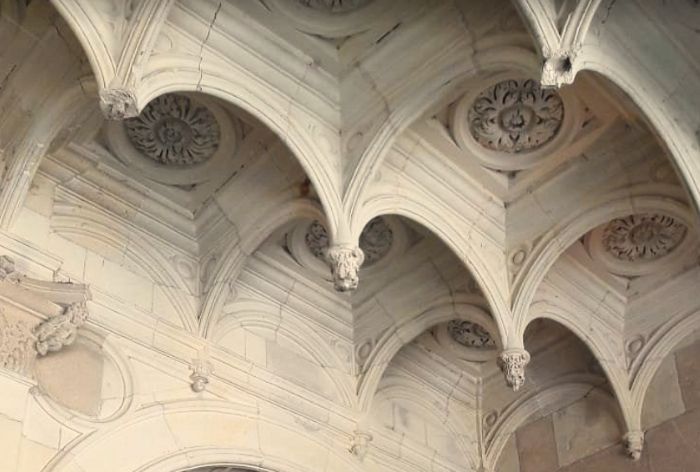
The Grand Staircase / What to See at Château d’Azay-le-Rideau
The Attic (Grand Comble)
Located on the second floor, the Attic, Grand Comble, is a vast attic space tucked just under the steep slate roof and is one of the château’s most impressive architectural features.
When it was built, the Attic wasn’t meant for storage. It was a fully functional part of the château, often used by staff or for practical purposes like drying laundry or storing supplies. What makes it remarkable today is how well it was constructed.
The wooden framework, made from oak, is massive, beautifully preserved, and shaped like an upturned ship’s hull. This kind of design was typical of the period and required incredible skill.
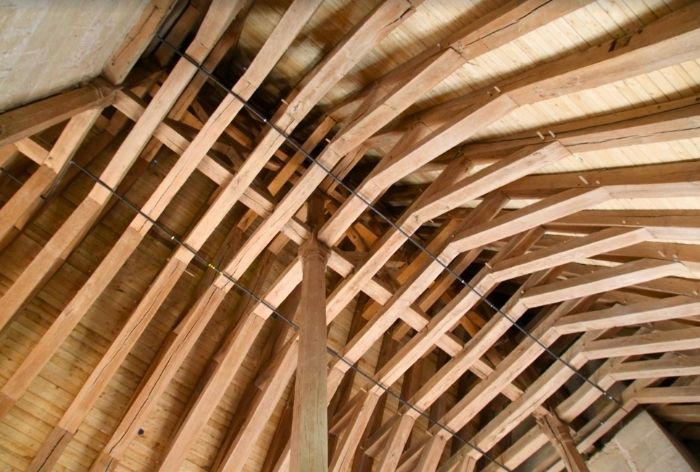
The Attic / What to See at Château d’Azay-le-Rideau
Renaissance Chamber (Chambre Renaissance)
If you want to see how French nobility lived during the early 1500s, the Renaissance Chamber is the place to start.
Located on the first floor, this room once belonged to Philippe Lesbahy, the wife of Gilles Berthelot, the man who built the château. It’s been carefully restored to reflect the style and atmosphere of the French Renaissance.
The first thing you’ll notice is the magnificent four-poster bed, covered in richly woven fabrics with patterns inspired by 16th-century designs. Beds like this weren’t just for sleeping, they were a symbol of power and status. Wealthy owners often received close friends and visitors in their chambers, and a bed this grand was meant to impress.
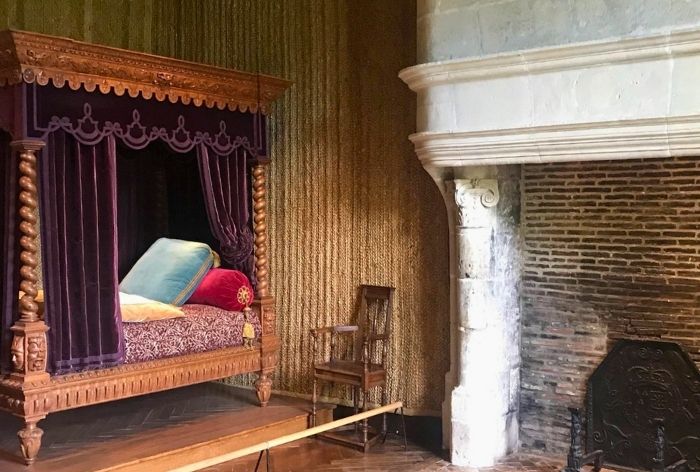
Renaissance Chamber / What to See at Château d’Azay-le-Rideau
One of the most interesting features of the room is the braided bulrush wall covering, a traditional method used in the Renaissance both to decorate and to insulate the walls. This technique was rediscovered and revived during modern restoration efforts, using natural materials similar to those originally used in the 1500s.
Psyche’s Chamber (Chambre de Psyché)
Psyche’s Chamber is one of the most beautiful and story-filled rooms at Château d’Azay-le-Rideau. It’s named after the stunning 16th-century Flemish tapestries that cover the walls.
Three large panels tell scenes from the myth of Psyche and Cupid, a popular tale during the Renaissance about love, betrayal, and redemption.
These tapestries were woven around 1575 and are rich in both color and detail. Back then, tapestries were more than decoration. They helped keep rooms warm and were a sign of wealth and good taste.
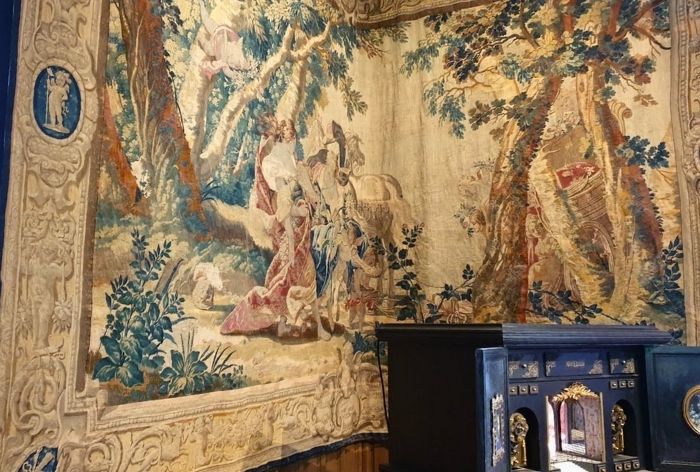
Psyche’s Chamber / What to See at Château d’Azay-le-Rideau
This room wasn’t just for sleeping. In the 1500s, a chamber like this had many uses, it could be a place to receive guests, do business, read, or rest.
The four-poster bed with its thick curtains added warmth and privacy. There’s also a fireplace bench that could swivel so you could warm yourself on both sides, a clever little luxury of the time.
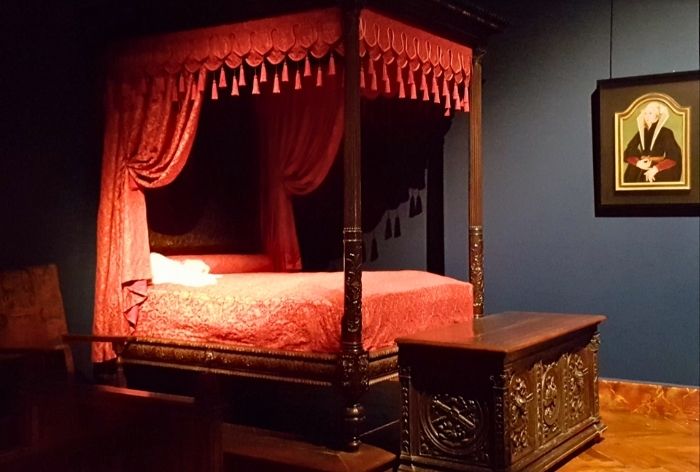
Psyche’s Chamber / What to See at Château d’Azay-le-Rideau
The Great Hall (Grande salle)
Walk into the Great Hall at Château d’Azay-le-Rideau, and you’ll instantly feel the shift. This space was made to impress!
Located on the first floor, it was the heart of public life in the château during the 16th century. Whether it was hosting dinners, discussing politics, or entertaining guests, this room saw it all.
The first thing that catches the eye is the massive stone fireplace, carved with intricate detail. At its center is a salamander, the emblem of King Francis I. He was a major patron of Renaissance art and architecture, and his symbol here is a clear sign of loyalty and influence.
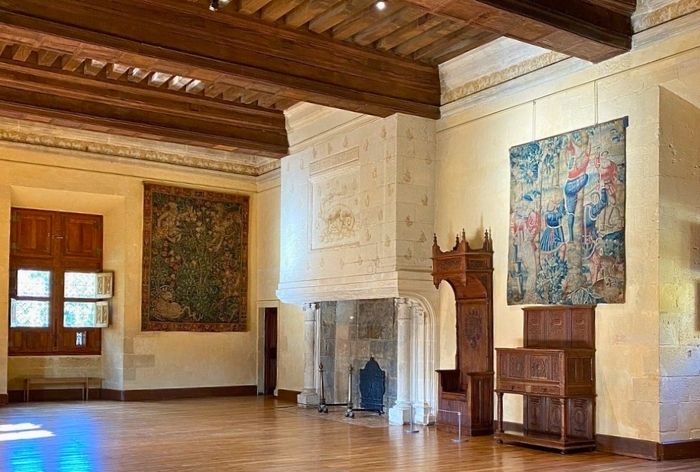
The Great Hall / What to See at Château d’Azay-le-Rideau
The salamander was believed to live in fire without being harmed, making it a powerful image of strength and resilience.
The walls are covered with Flemish tapestries from the 16th and 17th centuries, which are not just decorative. In those days, thick woven textiles helped keep out the cold and added a layer of warmth to these stone-walled spaces. The deep blue paint, popular in Renaissance interiors, gives the room a bold and stately feel.
King’s Chamber (Chambre du Roi)
Though it’s called the King’s Chamber, this richly decorated room only hosted royalty once, but what a visit it was. In 1619, King Louis XIII stayed at Château d’Azay-le-Rideau for two nights. This brief royal visit was enough for the room to earn its lasting title.
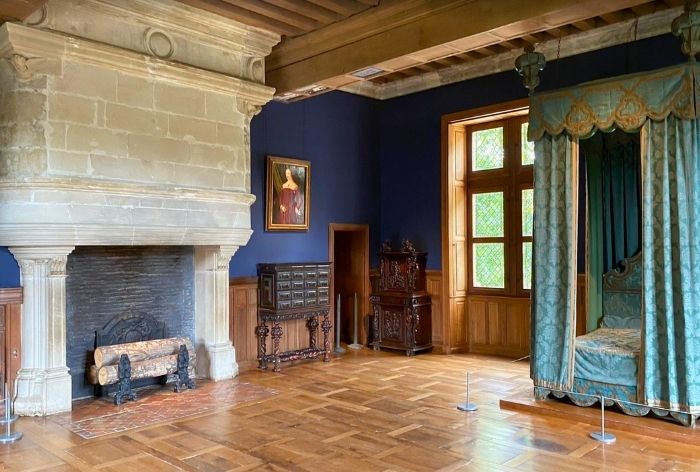
King’s Chamber / What to See at Château d’Azay-le-Rideau
One of the most striking pieces is a cabinet made of dark pearwood, crafted to mimic the look of expensive ebony. It’s not just beautiful; it’s detailed with ivory and bone plaques that show scenes from the Thirty Years’ War, a brutal conflict that raged during Louis XIII’s reign.
Right in the center of the cabinet is a more peaceful image: “The Four Ages of Man”, an engraving by Abraham Bosse, a talented artist born in nearby Tours in 1602.
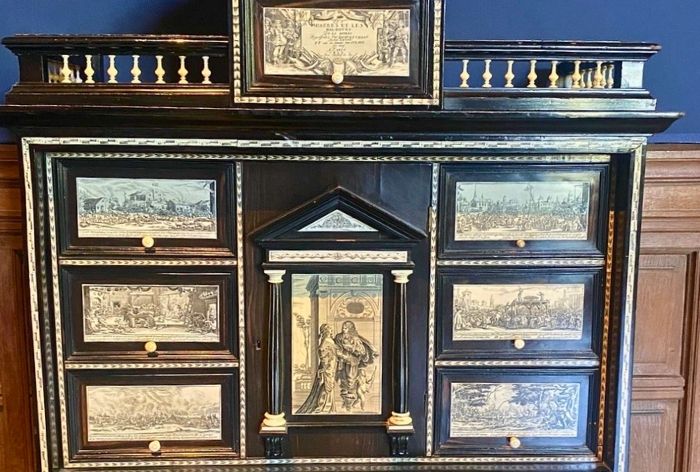
Cabinet in King’s Chamber / What to See at Château d’Azay-le-Rideau
The walls of the chamber are dressed in tapestries from the 17th century, based on artwork by Simon Vouet, a major French painter of the time. They illustrate scenes from Jerusalem Delivered, a popular epic poem by Torquato Tasso that blends fantasy, romance, and the Crusades.
Biencourt Salon (Salon Biencourt)
The Biencourt Salon is a tribute to the 19th-century revival of Renaissance style and to the family who saved the château from ruin.
Named after the Biencourt family, who owned Château d’Azay-le-Rideau from the late 18th to the 19th century, this richly decorated room reflects their love for history, art, and architecture.
By the time the Marquis de Biencourt inherited the château, it had seen better days. He set out to restore it, not just structurally, but stylistically. The salon was transformed into a neo-Renaissance space, full of nods to the château’s 16th-century roots but shaped by 19th-century tastes.
One of the most striking features is the massive stone fireplace, carved with the royal salamander symbol of King François I.
Around the room, you’ll also spot portraits of French royalty, part of a collection once numbering over 300 pieces, assembled by the Biencourts to honor France’s grand past.
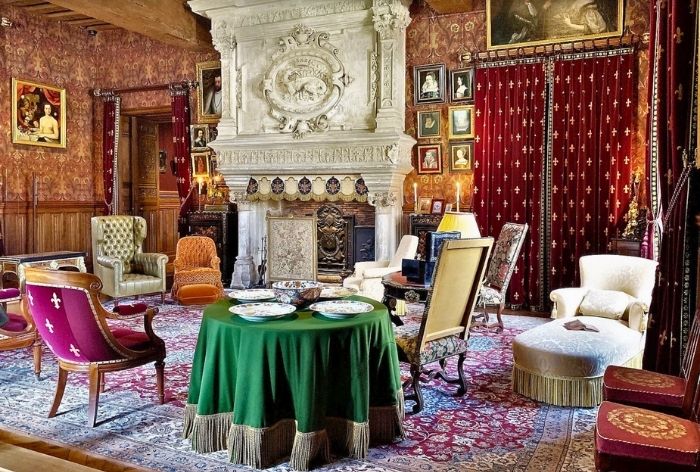
Biencourt Salon / What to See ay Château d-Azay-le-Rideau
Billiards Room (Salle de billard)
The Billiards Room, designed during the Biencourt family ownership, was part of a larger push to modernize the château while keeping its Renaissance charm alive.
As soon as you enter, you’ll notice the stone fireplace carved with the salamander emblem of King François I.
But this room isn’t just about old symbols; billiards was a fashionable pastime, especially among the upper classes.
The décor echoes the rest of the château: rich wood paneling, carefully selected tapestries, and elegant furniture that blends comfort with style.
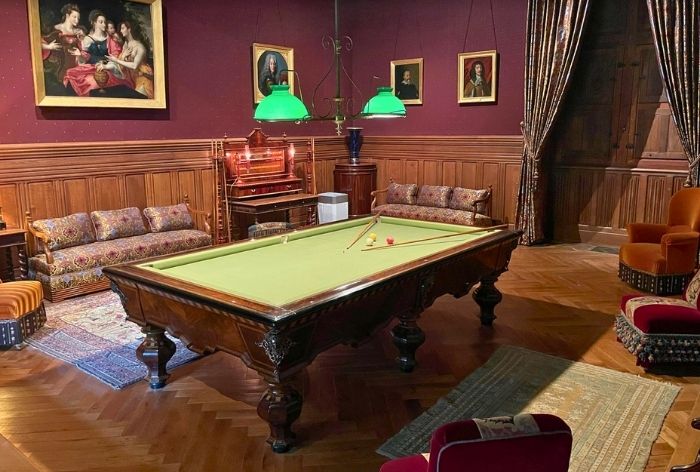
Billiards Room / What to See at Château d’Azay-le-Rideau
Dining Room (Salle à manger)
The Dining Room feels like stepping into a 19th-century dinner party just before the guests arrive.
Located on the ground floor, the room was reimagined during the 1800s when the Biencourts owned the château. The furniture, restored with help from the Mobilier National, includes classic 18th- and 19th-century pieces—a nod to both tradition and their aristocratic lifestyle.
The long dining table is carefully set with porcelain serviceware, evoking the grandeur of formal meals where presentation mattered as much as the food. These porcelain pieces, styled after the Louis XV period, were as much about showing social status as serving dinner.
The fireplace, wood paneling, and soft wall coverings help tie the room into the château’s older Renaissance roots. But the overall atmosphere is unmistakably 19th-century.
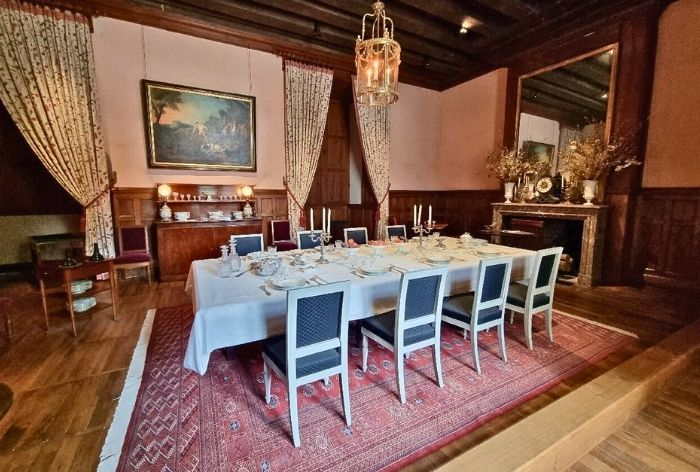
The Dining Room / What to See at Château d’Azay-le-Rideau
Salon-Library (Salon-Bibliothèque)
If there’s one room at Château d’Azay-le-Rideau that captures the quiet elegance of 19th-century life, it’s the Salon-Library. Tucked away on the first floor, this was the Biencourt family’s private retreat, a place to read, reflect, and entertain in comfort.
The room was restored based on an 1854 furniture inventory, which helped curators recreate the authentic atmosphere of the time. You’ll see plush Louis-Philippe style armchairs, cozy bergères, and even small gaming tables.
The walls are covered in canvas panels, painted with botanical motifs that echo the natural beauty surrounding the château.
Also tucked into the space are musical boxes, likely used during gatherings or for quiet evenings.
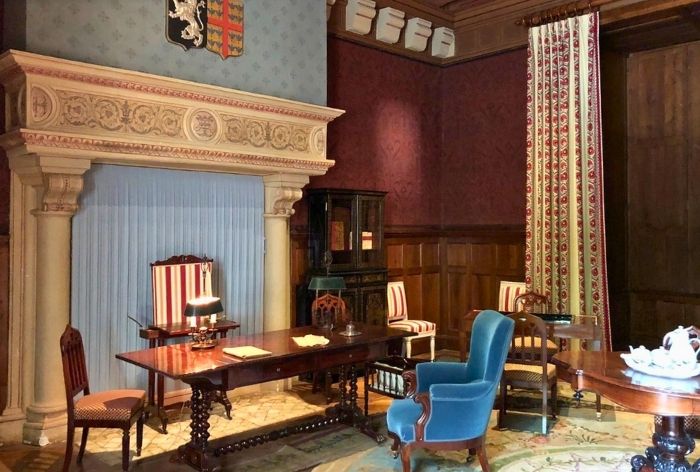
The Salon-Library / What to See at Château d’Azay-le-Rideau
The Gardens
The Gardens were redesigned in the early 1800s by Charles de Biencourt, a devoted botanist and owner of the château at the time.
He wanted the landscape to reflect the ideas of harmony and natural beauty, so he replaced the straight lines of French gardens with gentle curves, winding paths, and wide lawns shaded by trees from around the world.
You’ll spot cedars of Lebanon, bald cypresses, and tulip trees, unusual species introduced during that period as botanical “trophies.”
One of the highlights is the way the château seems to float, perfectly reflected in the calm waters of the Indre River that wraps around the island like a mirror. This was intentional; the reflection became part of the garden’s design, adding a touch of poetry to the experience.
In 2014, the park underwent a major restoration to bring back its 19th-century layout. The paths were rebuilt, old footbridges repaired, and lighting upgraded—carefully respecting the original design. Even the trees were studied and replanted to restore the visual balance and plant variety that the Biencourts had originally envisioned.
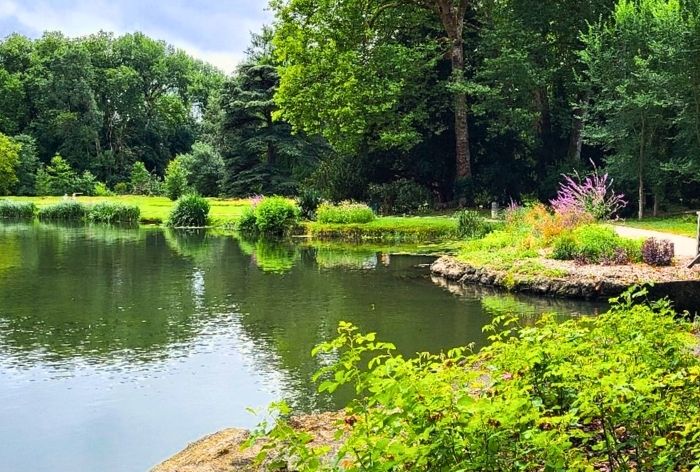
The Gardens / What to See at Château d’Azay-le-Rideau
Practical Tips for Visiting Château d'Azay-le-Rideau
Getting to Château d'Azay-le-Rideau
Château d’Azay-le-Rideau is tucked away in the charming village of Azay-le-Rideau, about 15 miles (24 km) southwest of Tours.
By Car: If you’re driving, it’s a straightforward route from Paris, Tours, or even Poitiers. From Paris, hop on the A10 motorway and then take the A85 towards Angers. A quick exit onto the D751 will lead you right into Azay-le-Rideau. From Tours, just follow the D37.
By Train: If you’re coming from Paris, a high-speed TGV from Montparnasse station gets you to Tours in just about an hour. Then, a quick 20-minute local train will bring you to Azay-le-Rideau. If you’re already in Tours, it’s even easier, just hop on a train for a 20-minute ride, and you’ll be there in no time. The train station in Azay-le-Rideau is a short 20-minute walk from the château.
When visiting Château d’Azay-le-Rideau, you’ll find convenient parking options nearby. The main parking area, Parking du Château, is located at 1 rue des Compagnons, just a short walk from the château entrance.
This lot offers 362 spaces, including spots for disabled parking and electric vehicle charging stations.
Additionally, there are other parking areas in the village, such as Parking du Sabot, located approximately 132 meters from the château.
Tickets and Opening Times
Château d’Azay-le-Rideau is open year-round, but opening hours vary depending on the season.
As for tickets, there’s a standard admission fee, with discounts for children, students, and EU residents under 26. Entry is free for children under 18 and for many visitors on the first Sunday of each month (outside the busy summer season).
For the latest information on ticket prices, special events, and seasonal hours, check the official website here: www.azay-le-rideau.fr
Where to Eat at Château d'Azay-le-Rideau
If you’re hoping to grab a bite while exploring the château, here’s the scoop: there’s no restaurant or café on-site. But don’t worry, just steps away in the town of Azay-le-Rideau, you’ll find plenty of options to satisfy your appetite.
If you’re in the mood for something special, head to Côté Cour, located right outside the château gates. This charming spot offers delicious French cuisine with a focus on local, seasonal ingredients.
If you’re on the go and need something quick, check out Volo Il Gelato Paradiso for some of the best ice cream around. It’s great for a light snack or dessert and a fun way to cool off during a warm day of exploring.
How Much Time Is Needed
If you want to truly soak in everything Château d’Azay-le-Rideau has to offer, plan to spend around 2.5 to 3 hours on your visit. It’s not a huge château, but there’s plenty to see and you’ll want to take your time.
Give yourself about an hour just to enjoy the outside. The château’s setting on an island in the Indre River is breathtaking, and the 19th-century English-style park deserves a slow wander.
Plan for 1.5 to 2 hours to explore the interior.
If you’re short on time, you could do a quicker visit in about 1.5 hours, but for a more relaxed experience, the extra time is absolutely worth it.
Here Are Some More Ideas of Places to Visit in France:
How to Visit Fontainebleau on a Day Trip from Paris (13 Best Things You Can’t Miss)
13 Tips for First Visit to Rouen to Help You Explore the City
DIY Walking Tour of Rouen (17 Best Stops, Map and Tips)
What to See at Château de Chaumont-sur-Loire (12 Things You Can’t Miss + Useful Tips)
How to Spend 6 Days in the Loire Valley (Detailed Itinerary + Practical Travel Tips)
7 Must-See Châteaux in the Loire Valley for First-Time Visitors (What to See + Practical Tips)
Perfect One Day in Étretat (5 Top Things You Can’t Miss + Practical Tips)
Did You Find It Useful? Why Not Save What to See at Château d'Azay-le-Rideau to Pinterest!


Now, It Is Your Turn, I Would Like to Hear Back from You!
Are you planning your trip to France?
Please let me know! Drop me a quick comment right below!
Click on any of the images below to get inspired and to help you with the planning process for your trip to France!
